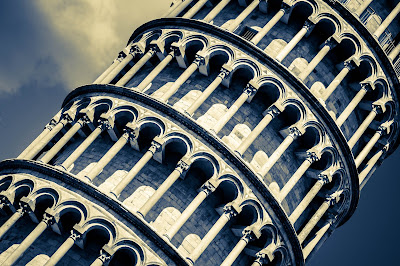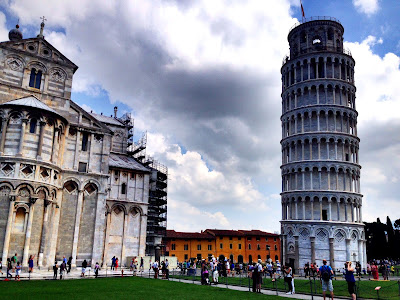 |
| image source: Ivo Paunov via Flickr |
SPECS:
Height: 55.86 metres on low side
56.67 metres on high side
Lean: 3.99 degrees
5.5 degrees (before restoration in 1990-2001)
Weight: 14,500 metric tons
Architect: Bonanno Pisano
Location: Pisa, Italy
200 Years of Construction
Construction started on it in 1173 and, almost two centuries later (and after two work stoppages), completed in the 1370s. By 1178, workers had made it to the third story of the structure, which was already tilting slightly to the north. Military conflicts with other Italian states would soon halt progress on the tower, which would not resume until 1272. This time, construction only remained underway for 12 years before another war again stopped the work. A final wave of construction picked up again in the early 14th century, concluding with the installation of a bell chamber in 1372.
Lean switched its direction
In 1272, when the construction work resumed, the addition of floors in the tower has a devastating effect on the tilt and it actually shifted the centre of gravity of the tower emanating in the shift of tilt from northward leaning to southward.
 |
| image source: Dara via Flickr |
Pisa got its name in 600 BC from a Greek word meaning “marshy land”.
Captivating structure- American troops refrained from ordering an artillery strike
During World War II, the tower served as a military base for Germans. In 1944, american troops who were sent to destroy all the structures in action against Germans, refrained from ordering an artillery strike, leaving the marvelous tower unimpaired.
Mussolini's effort to restoration
Mussolini, thought a wonky tower was a wholly unfit symbol for Fascist Italy and tried to restore its verticality, by drilling holes through the floor and pouring 80 tons of concrete into the foundations. The heavy cement caused the base of the tower to sink deeper into the soil, resulting in an even more severe lean.
 |
| image source: madridengineering |
CAUSE OF THE TILT
The exact cause of the tilt was not fully understood until 2001, when a serious stabilization effort (which began in the 1990’s) was completed. It was known prior to the start of this stabilization effort that the tower had been built atop an inadequate foundation (which was only 3 meters thick); and was constructed on very soft silty soil. Had these been the only factors at work, uniform settlement of the tower could have been expected; and the city of Pisa would play host to a significantly less famous (albeit more vertical) tower. The 800 year old mystery was finally solved by John Burland, an English geotechnical engineer, who discovered that the primary cause of the tilt was a fluctuating water table which would perch higher on the tower’s north side, causing the tower’s characteristic slant to the south.
With the restoration works carried out, the tower is predicted to sustain without any further deviation up to 200 years.
IMAGE GALLERY
 |
| image source: Gianluca Amato |
 |
| image source: Staffan Hamnas |
 |
| image source: Daphne0507 |